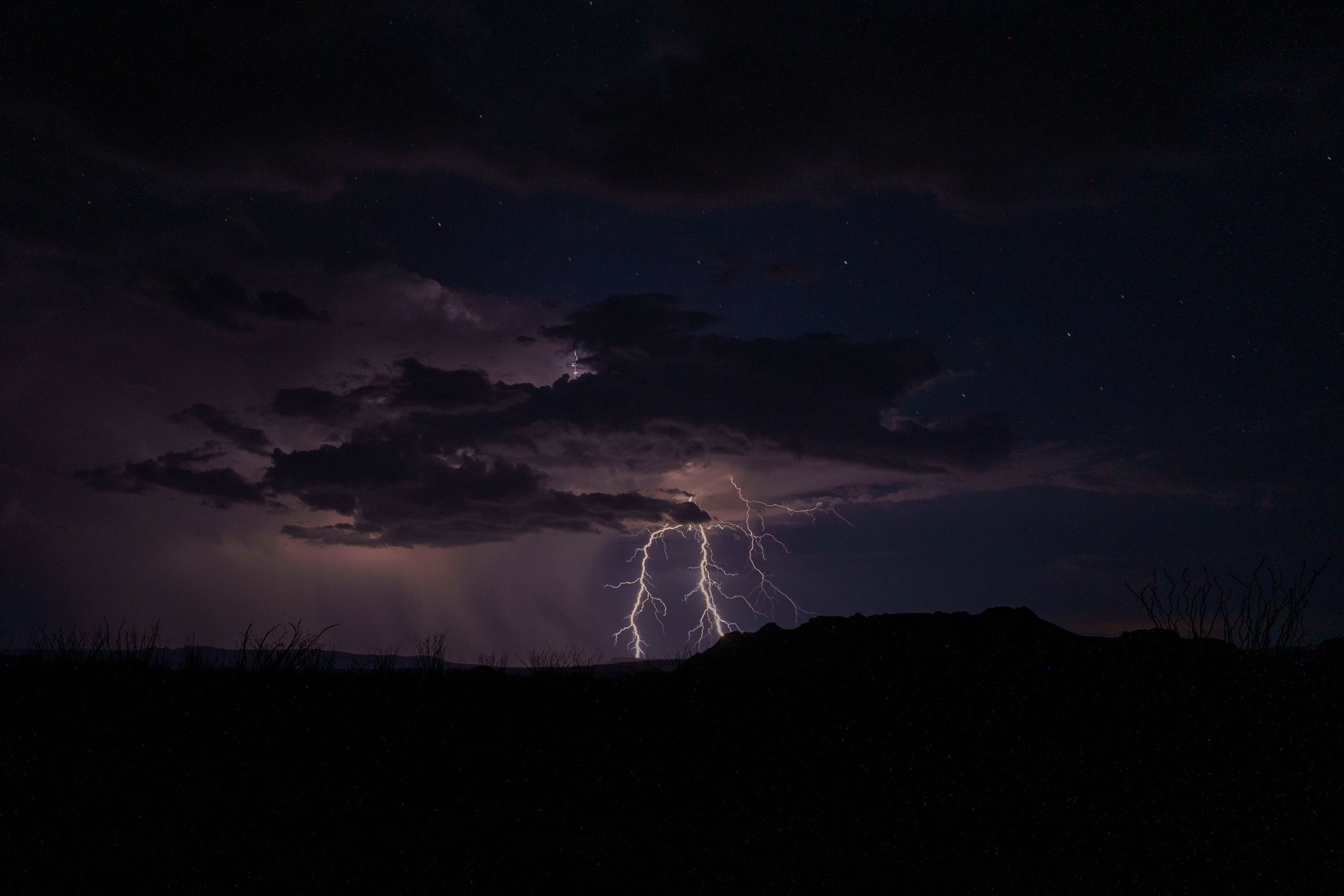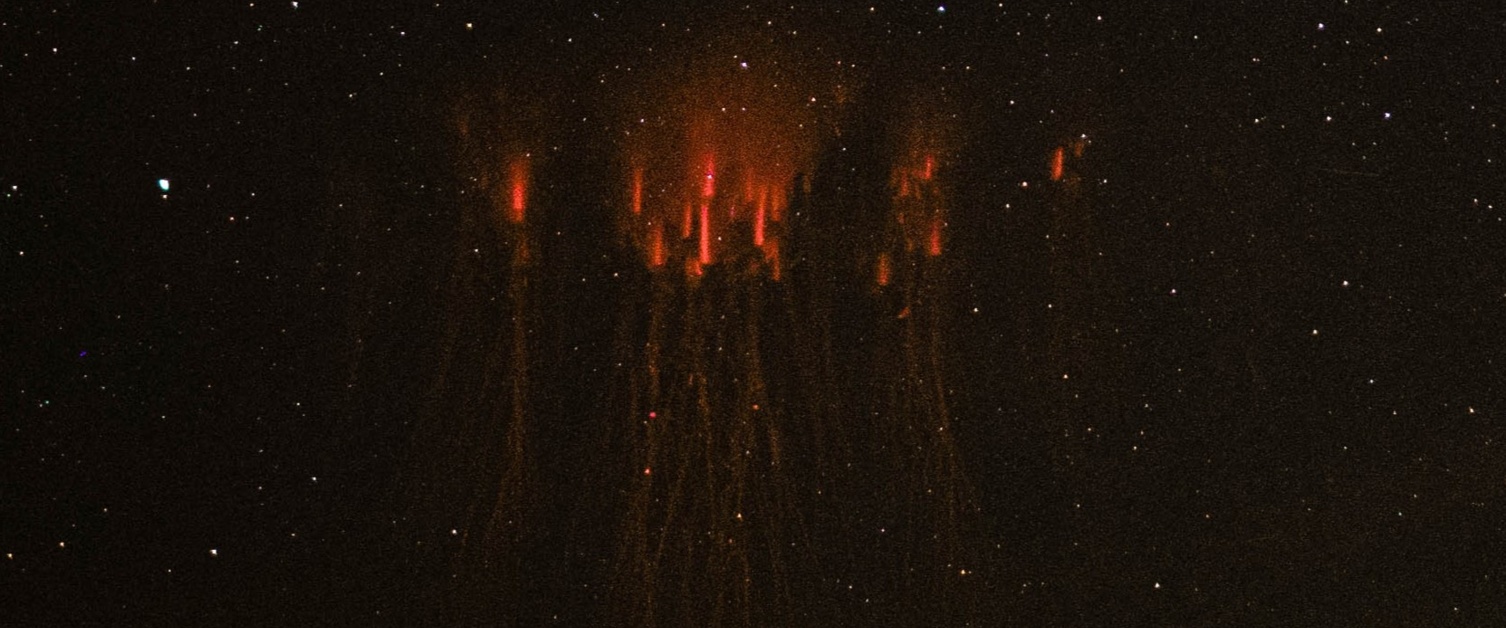Chasing Sprites
- By George Preoteasa
- Feb 28, 2023
Jellyfish Sprite by George Preoteasa
I don’t remember when I first learned about sprites, but I remember thinking “this is incredible!” When I say sprites, I mean a type of transient luminous effects that can be seen above storms that produce powerful lightning. Although they are very large, sprites are faint and of very short duration, which makes them almost impossible to see and really difficult to photograph. So, I decided to go with a commercial operator, Paul Smith, well known for his ability to find and photograph sprites. Here is my adventure.
Paul picks me and another chaser up from Oklahoma City. We drive south into Texas. Paul uses radar images to identify the storms with potential for sprites. The storms need to meet some conditions: they need to be intense, capable of producing strong positive cloud-to-ground lightning; must be stationary or slow moving; must continue into the night when sprites can be photographed. Storms created or supported by a low level jet may meet these conditions.
Once he decides on a target, he looks at positioning. The ideal distance to the storm is between 100 and 300 miles. At that distance, you can see the sprites above clouds. There must be minimal light pollution where you are and all the way to the storm.
We drive southwest for a few hours and have a quick meal in Abilene. From there, we head almost directly west. There is a promising storm in New Mexico. It’s already dark when we stop on a deserted country road by the entrance gate of a ranch. These ranches seem to be quite common in Texas, large properties surrounded by a fence and with gates that don’t seem to have been opened in a long time. Nobody will bother us here. We see distant flashes of light. Paul confirms that is the direction we should be shooting in and suggests using a 35mm focal length lens. Sprites are enormous, their tops can reach 55 miles. From 130 miles (which is the estimated distance to the targeted storm), a large sprite, surrounding sky and some foreground would fit in the frame. I start shooting using an intervalometer, taking a picture every 4 seconds with minimal gap between shots so as not to miss anything. I use the maximum lens aperture, f/1.4 and ISO 3200. I also use a second camera with a 20mm lens and similar settings. Now we wait. It’s a beautiful night. The sky is clear, no moon and you can clearly see the Milky Way. No bugs either even though it’s late June.
![]()
Photo: Columns sprite
At some point Paul exclaims “I saw it!” We stop shooting and look at the recent frames. Yes, there it is! My first sprite! Paul says that it takes 10-12 minutes for the storm to “recharge” before it produces another sprite. We continue to shoot until the storm seems to be abating. Back at the hotel, well after midnight, instead of sleeping, I go through hundreds of frames on the back of the camera. I find a couple more with sprites. I’m happy, but my enthusiasm is somewhat tempered now.
The first night turns out to have been the best. On the second night the sky between us and some more distant storms is rather light polluted and no sprites can be photographed. On the third night we are in Big Bend National Park to aim at some storms in Mexico. No success here either, although we have an opportunity to photograph lightning produced by a smaller storm not too far, and have a superb view of the Milky Way.

Photo: Lightning in Big Bend NP
On the fourth night luck smiles on us again. There are two storms that can produce sprites at approximately 300 miles. I capture some sprites with a 50mm lens. At that distance, a longer focal length lens would yield a bigger sprite, however, there is uncertainty in aiming. Unlike the first day, when we were a lot closer to the storm, there is little direct visual indication of exactly where the lightning activity is, so we may be aiming just to the side of the action. Of course, the sprites appear smaller in the picture. That night I get the most sprites, though of lower quality. One however is precious. It’s a “jellyfish”, the most coveted sprite.
![]()
Photo: Jellyfish sprite
Heading into the fifth and last night, we are rather tired and having obtained what we wanted, we do not stay very late. However, we have an interesting incident, the sheriff’s deputy comes to check on us. We suspect someone from a lonely house half a mile away was intrigued by our activities. To be fair, I would be too. We explain we are taking pictures of the sky and the deputy leaves us alone.
Next day, we get dropped off at OKC to take our flights back home. Once I get home, I will again go through two 512GB SD cards which I almost filled up.
Looking back, this was an exceptional experience. Of course, I was able to get the sprite photographs (one of which was among the finalists in the Weather Band 2022 Photo contest), but I also greatly enjoyed the company of people with the same interests as well as seeing new places, watching storms in an open field by day and being under clear dark skies at night.

Photo: Milky Way and airglow in Big Bend NP
Bio:
George considers himself a weather and sky enthusiast. He has a degree in Atmospheric Physics from the University of Bucharest, Romania, however, early on he opted for a career in information technology. George watches the weather closely and is often out taking still and time lapse pictures of objects in the sky including clouds, atmospheric optical phenomena, the Milky Way, deep sky objects, eclipses, aurora borealis. He is a member of the Cloud Appreciation Society, and several amateur astronomy clubs. You can see George’s pictures and time-lapse movies at https://www.instagram.com/gvpreo/ and https://vimeo.com/gvpreo.
